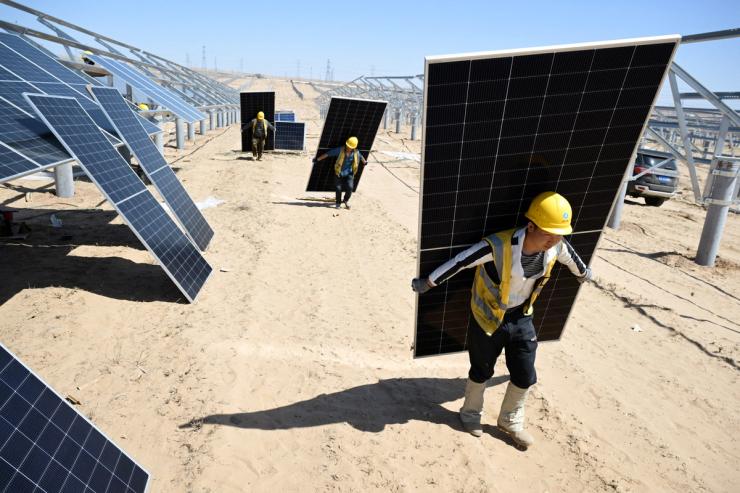The News
The world is heading into an era of energy oversupply, with US-backed LNG and China-backed solar competing for the hearts — and wallets — of emerging markets.
Beijing and Washington are betting on opposite energy futures. The International Energy Agency’s latest World Energy Outlook shows each country building massive energy export capacity: China in solar panels and batteries, the US in LNG terminals. Even as global demand grows, the world doesn’t need them both.
The LNG industry is ramping up supply; export capacity is set to rise 50% to 2030. The US is leading the charge, accounting for more than half the buildout. The country will add as much capacity in the next five years as it built in the previous decade. Even the IEA asks pointedly: Where will it all go?
The overcapacity story doesn’t stop at LNG. The IEA report also highlights the “surplus capacity” of solar and battery manufacturers, most of which is in China. Solar PV manufacturing capacity runs at twice the current global demand; battery capacity runs at three times. China alone has enough solar manufacturing capacity today to meet total global demand through 2030, even under the IEA’s most ambitious net-zero scenario.
The battle over overcapacity has become another front in the US-China rivalry. The looming stranded assets matter less; both economies are large enough to absorb the hit. The real stakes are higher: Which country will become the energy supplier to the developing world, bringing with it the influence that entails? And whose leaders see the future more clearly — who is ahead of the curve, and who is stuck in the past?
There are two main reasons why the US’ LNG bet looks more vulnerable than China’s electrotech bet.
First, solar outshines LNG as a source of electricity generation. It is cheaper, faster to deploy, and local. Solar-plus-battery projects across Asia and Europe now cost less than the running costs of gas plants burning imported LNG.
For energy-hungry emerging markets, LNG has to compete on speed, as well as on cost. LNG projects take five to 10 years to realize. Solar can be up and running in less than a year. The result: Solar demand is fundamentally more elastic, responding faster to falling prices.
Take Pakistan, for example. In just a few years, its solar imports from China have doubled the country’s electricity capacity. A similar surge is now underway in Africa.
The second — and more fundamental reason — is that the world increasingly wants electricity, not fossil fuels. Here again, China is skating to where the puck is going. As the IEA notes, “the Age of Electricity” has arrived. Electricity is the energy carrier of 21st-century growth.
Investment flows documented by the IEA tell the story: Spending on power supply and electrification already accounts for half of all global energy investment.
There are strong efficiency and security reasons why electrotech is winning out against fossil fuels. Electricity is simply more efficient than burning fossil fuels, which waste most of their energy as heat. Then there is security: For the three-quarters of the world that imports fossil fuels, electrification is the primary path to energy independence.
No country has internalized this reality more than China. Over the last decade, it has increased economy-wide electrification by 10 percentage points while doubling electricity demand. This electricity-first industrialization is now rippling outward from eastern China into the developing world. Southeast Asia now has a higher rate of electrification than the US, and China’s EV exports are surging across Latin America and Asia.
The danger for the US is mistaking domestic energy patterns for global trends. For most of the 20th century, a useful heuristic held: To glimpse the future of technology, look to America. For energy technology, that’s no longer true. In 2000, China accounted for roughly 5% of clean energy patents filed. Today it’s three-quarters.
The stakes extend wider. Can the US win in AI if it’s losing in electricity? As US Interior Secretary Doug Burgum recently observed, the old adage “knowledge is power” is being inverted. In the age of AI, power is knowledge. And China is far better positioned to scale cheap, abundant electricity.
LNG versus solar is more than a competition between technologies. It’s a clash of visions between the world’s two economic giants. When superpowers’ visions diverge this sharply, history can offer guidance. And if the history of energy has an arc, it bends toward solutions that are leaner, cheaper, and more secure.
On every measure, solar beats LNG.
Kingsmill Bond, CFA is an energy strategist at global energy think tank Ember, formerly at Deutsche Bank and Citibank. Sam Butler-Sloss is a research manager at Ember, previously at the Rocky Mountain Institute and the Carbon Tracker Initiative.
Notable
- The race for global influence is increasingly being defined as a competition between “petrostates” and “electrostates,” two experts from Columbia University’s Center on Global Energy Policy wrote in The National Interest.
- The US LNG boom carries with it climate risks, as well as economic ones, according to Yale Environment 360.

